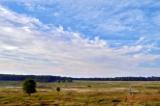 © Bruce McNitt/Panoramic Images (Virginia)
© Bruce McNitt/Panoramic Images (Virginia)

The Virginia Biodiversity Assessment: A Spatial Summary of Confirmed Biodiversity Ranked by Conservation Need
The Virginia Natural Heritage Program (VNHP) in the Department of Conservation and Recreation has developed various GIS planning tools to facilitate land conservation with the ultimate goal of protecting biodiversity. One of these tools, the conservation sites layer, maps habitats of known populations of rare plants and animals, and locations of exemplary natural communities, providing each site with a biodiversity significance ranking. While this layer has great utility for conservation planning, it does not indicate where biodiversity might be threatened by development or misguided land management. Thus, the Virginia Biodiversity Assessment (VBA) was initiated to not only summarize known biodiversity but to prioritize it by the degree to which it is protected. This project utilized conservation sites, stream conservation units, element occurrences, and conservation lands layers from VNHP, and threatened and endangered waters, species observations, and Wildlife Action Plan (WAP) layers from the Department of Game and Inland Fisheries (DGIF).
This project began with a land use change detection analysis to focus the assessment on sites below a certain development threshold. Species and natural community locations data were intersected with the conservation lands layer, and their proportions conserved were calculated. The management intent and legal protection status, two attributes of lands in the conservation lands database, were also captured for those lands harboring rare species and natural communities. With this calculation current “percent conserved” values for all species and natural communities locations were estimated.
The species and natural community locations data are also attributed with rankings that address state and global rarity, and the quality of each occurrence. Locations data were ordered by global rarity, occurrence quality, state rarity, management intent, legal protection status, and proportion conserved, then assigned ranks based on this order. Collectively, these ranks were used to calculate Biodiversity Conservation Need (BCN) scores ranging from moderate to critical to indicate the urgency with which sites need to be conserved for biodiversity. For Part II of this analysis, the results from Part I will be combined with the highest priority features from the Virginia Natural Landscape Assessment and additional tiered species layers from the WAP (also available for viewing on LandScope) to produce a comprehensive synthesis of Virginia’s biodiversity information. The VBA was funded by the Virginia Coastal Program, the Virginia Land Conservation Foundation, and Landscope America.





